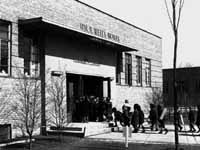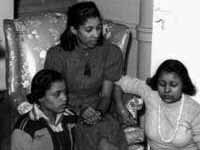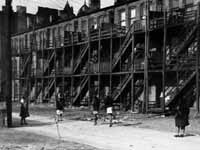
Map Showing Ethnic Neighborhoods of Chicago
|
Ethnography focusses on the customs of particular tribes or
peoples. Ethnographers are generally anthropologists well- trained in the
use of elementary mapping and linguistic principles. This ethnographic map
of 1926 Chicago shows the communities of different ethnic groups, including
blacks.
The Social Base Map of Chicago: Showing Industrial Areas, Parks,
Transportation and Language Groups, Illinois, Chicago (city) Ethnography,
1926 University of Chicago Local Community Research Committee Chicago:
The University of Chicago, 1926 Map Geography
and Map Division (118)
|
![[The Chicago Defender and Black Migrants from the South, Adams letter]](images/adams0.jpg)
![[The Chicago Defender and Black Migrants from the South, Galliard letter]](images/galliar0.jpg)
The Chicago Defender and Black Migrants from the South [Adams
letter][Galliard letter]
|
The Chicago Defender was a remarkably successful
in encouraging blacks to migrate from the South to Chicago, often listing
names of churches and other organizations to whom they could write for help.
As a result, thousands of prospective migrants wrote letters to black churches,
such as the Bethlehem Baptist Association in Chicago, Illinois, which assumed
the task of helping black migrants find housing and employment. They also
helped migrants to adjust to their new environment.
[Letter from Mrs. J. H Adams, Macon, Georgia, to the Bethlehem Baptist
Association in Chicago, Illinois,] 1918 Holograph Carter G. Woodson Papers
Manuscript Division (119)
[Letter from Cleveland Galliard of Mobile, Alabama, to the Bethlehem
Baptist Association, Chicago, Illinois,] 1917 Holograph Carter G. Woodson
Papers Manuscript Division (120)
|

Chicago Community Center
|
The geographic isolation and discriminatory school policies
imposed on urban blacks gradually lowered the quality of their public education
system and inspired the use of stopgap measures to solve such problems as
overcrowding. For example, the Ida B. Wells housing project community center
was used to alleviate overcrowding in the kindergarten classes of the Chicago
school system.
Ida B. Wells housing project, Chicago, Illinois, April 1942 Jack Delano,
Photographer Photomural from gelatin-silver print FSA-OWI Collection Prints
and Photographs Division (121)
|

National Youth Administration Meeting
|
The National Youth Administration, signed into law by President
Franklin D. Roosevelt in 1935, was the only New Deal agency primarily designed
to meet the employment and educational needs of American youth. By December
1940, resident training centers had been established for rural youths, blacks,and
students. Each center had a "Citizenship Instructor" who held youths to
practice the business of self-government.
National Youth Administration girls and their instructor at the Good
Shepherd community center, Chicago (south side), Illinois, April 1941
Russell Lee, Photographer Photomural from gelatin-sliver print FSA-OWI
Collection Prints and Photographs
Division (122)
|
![[Fighting Job Discrimination, milk company picket]](images/dairy0.jpg)
![[Fighting Job Discrimination, picket line]](images/picket0.jpg)
|
In "the Promised Land" of Chicago, many black migrants still
had to join picket lines to fight for fair wages. Some foremen in various
companies discriminated by placing restrictions upon the promotion and advancement
of black workers, frequently preventing them from earning higher wages.
Carrying a sign in front of a milk company, Chicago, Illinois, July
1941 John Vachon, Photographer Gelatin-silver print FSA-OWI Collection
Prints and Photographs Division
(123)
Picket line at the Mid-City Realty Company, Chicago, Illinois, July
1941 John Vachon, Photographer Gelatin-silver print FSA-OWI Collection
Prints and Photographs Division
(124)
|

Black-Owned Restaurant
|
Many of the black migrants who came to Chicago between 1910
and 1930 started businesses and became entrepreneurs. The "Perfect Eat"
Shop, a restaurant on 47th street near South Park, is an example of such
a business. It was owned by Ernest Morris, seen standing in the rear of
the restaurant.
The Perfect Eat Shop, a restaurant on 47th street near South Park, owned
by Mr. Ernest Morris, Chicago, Illinois, April 1942 Jack Delano, Photographer
FSA-OWI Collection Prints and Photographs
Division (125)
|

Apartment Building in Chicago's "Black Belt"
|
Chicago's South Side "black belt" contained zones related
to economic status. The poorest blacks lived in the northernmost, oldest
section of the black belt, while the elite resided in the southernmost section.
Apartment building in a black section of Chicago, Illinois, April 1941
Russell Lee, Photographer Gelatin-silver print FSA-OWI Collection Prints
and Photographs Division (126)
|

![[The Chicago Defender and Black Migrants from the South, Adams letter]](images/adams0.jpg)
![[The Chicago Defender and Black Migrants from the South, Galliard letter]](images/galliar0.jpg)


![[Fighting Job Discrimination, milk company picket]](images/dairy0.jpg)
![[Fighting Job Discrimination, picket line]](images/picket0.jpg)


![[Previous]](prev.gif)
![[Next]](next.gif)
 Library of Congress
Library of Congress